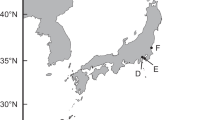Abstract
Peroxisomes of the digestive glands of mussels, Mytilus galloprovincialis Lmk, were investigated by immunoblotting and immunohistochemistry using rabbit antibodies against several mammalian hepatic peroxisomal proteins. Western blot analysis of main subcellular fractions revealed immunoreactive polypeptides with molecular weights comparable to those of the corresponding mammalian hepatic proteins. They could be localized to the peroxisomal matrix in the case of catalase, multifunctional enzyme (PH), and palmitoyl-CoA oxidase (AOX), and to the peroxisomal membrane in respect to PMP 70. The purification of peroxisomes by metrizamide density gradient centrifugation revealed the existence of two subpopulations with densities of 1.16 and 1.20 g cm–3 exhibiting different protein compositions. In paraffin sections, positive immunolabeling for catalase was distributed along the apical cytoplasm of the epithelia of digestive ducts and stomach and throughout the cytoplasm of digestive tubule cells. The peroxisomal β-oxidation enzymes, AOX and PH, also appeared predominantly in the ducts and the stomach epithelia with a weaker immunolabeling in the tubules. At the electron microscopic level a clear labeling with gold particles was observed in the peroxisomal matrix with the anti-guinea pig catalase antibody. In addition to peroxisomes, the anti-PH antibody also labeled the mitochondria. The similarity in the protein composition of molluscan and mammalian peroxisomes as revealed by the present study indicates that those proteins have been well conserved in evolution suggesting that functionally peroxisomes in molluscs could also be involved in the metabolism of lipids and in detoxification of xenobiotics. Thus, the antibodies tested could provide useful tools for detection of peroxisomal induction in molluscan biomonitoring programs for the assessment of aquatic environmental pollution.
Similar content being viewed by others
Author information
Authors and Affiliations
Additional information
Accepted: 19 October 1999
Rights and permissions
About this article
Cite this article
Cancio, I., Völkl, A., Beier, K. et al. Peroxisomes in molluscs, characterization by subcellular fractionation combined with western blotting, immunohistochemistry, and immunocytochemistry. Histochemistry 113, 51–60 (2000). https://doi.org/10.1007/s004180050007
Issue Date:
DOI: https://doi.org/10.1007/s004180050007




